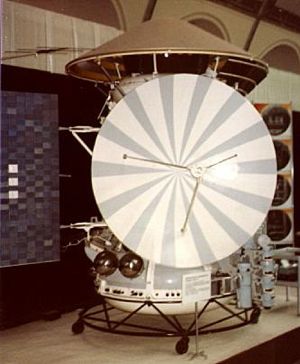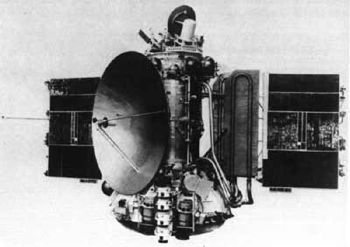
Home - Search - Browse - Alphabetic Index: 0- 1- 2- 3- 4- 5- 6- 7- 8- 9
A- B- C- D- E- F- G- H- I- J- K- L- M- N- O- P- Q- R- S- T- U- V- W- X- Y- Z
Mars M-73
 Mars 6, 7 / M-73 Credit: © Mark Wade |
AKA: M-73. Status: Operational 1973. First Launch: 1973-07-21. Last Launch: 1973-08-09. Number: 4 . Gross mass: 3,440 kg (7,580 lb).
Due to the unfavorable position of Mars during that campaign, separate versions built: two intended to orbit Mars and map the surface, and two to land capsules. The orbiters were equipped with instrumentation to study the composition, structure, and properties of the Martian atmosphere and surface, including an imaging device, a 256 channel gamma-ray spectrometer mounted on a boom and a Lyman-Alpha photometer. The landers would have separated from their uninstrumented bus, entered the atmosphere, where a parachute opened, slowing the descent.
The lander equipment included a Lyman-Alpha photometer and a Bennett mass analyzer. Unfortunately, this entire series of spacecraft experienced failures on arrival at Mars due to pre-flight test of the electronics with helium, which resulted in degradation of the computer chips during the journey to Mars. Orbiters had a launch mass of 3444 kg, and landers 3260 kg.
More at: Mars M-73.
Family: Mars lander. Country: Russia. Engines: KTDU-425A. Launch Vehicles: Mars tactical rocket, Proton, Proton-K/D. Projects: Mars. Launch Sites: Baikonur, Baikonur LC81/23, Baikonur LC81/24. Agency: MOM, Lavochkin bureau. Bibliography: 118, 2, 274, 296, 6, 67, 12805, 12806.
 | Mars 6 Credit: Manufacturer Image |
 | Mars 4 Credit: Manufacturer Image |
1973 July 21 - . 19:30 GMT - . Launch Site: Baikonur. Launch Complex: Baikonur LC81/23. LV Family: Proton. Launch Vehicle: Proton-K/D.
- Mars 4 - .
Payload: M-73 s/n 52S. Mass: 4,650 kg (10,250 lb). Nation: Russia.
Agency: MOM.
Program: Mars.
Class: Mars.
Type: Mars probe. Spacecraft Bus: 4MV.
Spacecraft: Mars M-73.
USAF Sat Cat: 6742 . COSPAR: 1973-047A.
Failed; did not enter Martian orbit as planned; intended to be a Mars orbiter mission. Mars 4 reached Mars on 10 February 1974. Due to use of helium in preflight tests of the computer chips, which resulted in degradation of the chips during the voyage to Mars, the retro-rockets never fired to slow the craft into Mars orbit. Mars 4 flew by the planet at a range of 2,200 km. It returned one swath of pictures and some radio occultation data. Final heliocentric orbit 1.02 x 1.63 AU, 2.2 degree inclination, 556 day period.
1973 July 25 - . 18:55 GMT - . Launch Site: Baikonur. Launch Complex: Baikonur LC81/24. LV Family: Proton. Launch Vehicle: Proton-K/D.
- Mars 5 - .
Payload: M-73 s/n 53S. Mass: 4,650 kg (10,250 lb). Nation: Russia.
Agency: MOM.
Program: Mars.
Class: Mars.
Type: Mars probe. Spacecraft Bus: 4MV.
Spacecraft: Mars M-73.
USAF Sat Cat: 6754 . COSPAR: 1973-049A.
Mars probe intended to enter Martian orbit and comprehensively photograph Mars. Parameters are for Mars orbit. Mars 5 reached Mars on 12 February 1974 and was inserted into a 1760 km x 32,586 km orbit. Due to computer chip failures the orbiter operated only a few days and returned atmospheric data and images of a small portion of the Martian southern hemisphere.
1973 August 5 - . 17:45 GMT - . Launch Site: Baikonur. Launch Complex: Baikonur LC81/23. LV Family: Proton. Launch Vehicle: Proton-K/D.
- Mars 6 - .
Payload: M-73 s/n 50P. Mass: 4,650 kg (10,250 lb). Nation: Russia.
Agency: MOM.
Program: Mars.
Class: Mars.
Type: Mars probe. Spacecraft Bus: 4MV.
Spacecraft: Mars M-73.
USAF Sat Cat: 6768 . COSPAR: 1973-052A.
Mars probe intended to make a soft landing on Mars. Total fueled launch mass of the lander and orbital bus was 3260 kg. It reached Mars on 12 March 1974, separated from the bus, and entered the atmosphere, where a parachute opened, slowing the descent. As the probe descended through the atmosphere it transmitted data for 150 seconds, representing the first data returned from the atmosphere of Mars. Unfortunately, the data were largely unreadable due to a flaw in a computer chip which led to degradation of the system during its journey to Mars. When the retro-rockets fired for landing, contact was lost with the craft. Mars 6 landed at about 24 degrees south, 25 degrees west in the Margaritifer Sinus region of Mars. Bus ended up in a final heliocentric orbit 1.01 x 1.67 AU, 2.2 degree inclination, 567 day period.
1973 August 9 - . 17:00 GMT - . Launch Site: Baikonur. Launch Complex: Baikonur LC81/24. LV Family: Proton. Launch Vehicle: Proton-K/D.
- Mars 7 - .
Payload: M-73 s/n 51P. Mass: 4,650 kg (10,250 lb). Nation: Russia.
Agency: MOM.
Program: Mars.
Class: Mars.
Type: Mars probe. Spacecraft Bus: 4MV.
Spacecraft: Mars M-73.
USAF Sat Cat: 6776 . COSPAR: 1973-053A.
Mars probe intended to make a soft landing on Mars. Mars 7 reached Mars on 9 March 1974. Due to a problem in the operation of one of the onboard systems (attitude control or retro-rockets) the landing probe separated prematurely and missed the planet by 1,300 km. The early separation was probably due to a computer chip error which resulted in degradation of the systems during the trip to Mars. Ended up in a final heliocentric orbit 1.01 x 1.69 AU, 2.2 degree inclination, 574 day period.
1974 February 10 - .
1974 February 12 - .
Back to top of page
Home - Search - Browse - Alphabetic Index: 0- 1- 2- 3- 4- 5- 6- 7- 8- 9
A- B- C- D- E- F- G- H- I- J- K- L- M- N- O- P- Q- R- S- T- U- V- W- X- Y- Z
© 1997-2019 Mark Wade - Contact
© / Conditions for Use